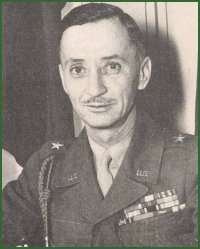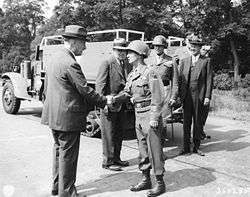John Howell Collier
John Howell Collier (8 September 1899 – 21 April 1980) was a lieutenant general in the United States Army. He was notable as a commander of 2nd Armored Division units in World War II and as the Army's Chief of Armor.
John Howell Collier | |
|---|---|
 General Collier with the 2nd Armored Division in World War II | |
| Born | September 8, 1898 Uvalde, Texas |
| Died | April 21, 1980 (aged 81) San Antonio, Texas |
| Buried | |
| Allegiance | |
| Service/ | |
| Years of service | 1914–1958 |
| Rank | |
| Commands held | 3rd Battalion 66th Armored Regiment Combat Command A, 2nd Armored Division 2nd Armored Division U.S. Army Armor Center and School I Corps Fourth United States Army |
| Battles/wars | Villa Expedition World War I World War II Korean War |
| Awards | Distinguished Service Medal Silver Star Legion of Merit Bronze Star |
Early life
Nicknamed "Pee Wee" because of his diminutive 5 ft 2 in (1.57 m) stature, Collier was born in Uvalde, Texas on September 8, 1898. He joined the Texas National Guard and served in the Villa Expedition.[1][2]
Subsequent military career
Collier attended the United States Military Academy, from which he graduated in 1918. After receiving his commission, Collier was assigned to Europe to carry out an observation tour of World War I battlefields.[3]
Assigned to the Cavalry branch, Collier completed the Cavalry Officer Basic Course in 1920.[4]
Collier served in assignments throughout the United States, including instructor at New Mexico Military Institute and postings to Ft. Riley, Kansas, Ft. Benning, Georgia, and the Philippines.[5][6]
Collier graduated from the Cavalry Regular Course in 1937, as well as the Advanced Equitation Course in 1938.[7]
World War II

After graduating from the Command and General Staff College in 1941, Collier was assigned to the 2nd Armored Division for World War II. He served in Africa and Europe as commander of the division's 3rd Battalion 66th Armored Regiment, and succeeded to command of Combat Command A when Maurice Rose was assigned to command the 3rd Armored Division. He then commanded the 2nd Armored Division from June to September, 1945.[8][9][10][11]
Post World War II
Collier continued his service after World War II, including high profile assignments as the Army's Inspector of Armor, and commander of the U.S. Army Armor Center and School.[12][13][14][15][16]
Korean War
After serving as the Chief of Armor, Collier assumed command of I Corps in Korea on July 13, 1954.[17] In November he was assigned additional duty as interim deputy commander of the Eighth United States Army until the arrival of the permanent deputy commander, Lt. Gen. Claude B. Ferenbaugh, in early January 1955.[18][19] Ferenbaugh retired at the end of June and Collier relinquished command of I Corps to become deputy commander of Eighth Army and U.S. Army Forces Far East.[20] He promptly made nationwide headlines when he attempted to prevent U.S. service members from fraternizing with South Korean women, an effort that proved unsuccessful when commanders in areas outside Eighth Army control did not follow Collier's example.[21][22][23][24]
Post Korean War
Collier returned to the United States in 1955 to assume command of the Fourth United States Army, where he served until his 1958 retirement.[25][26][27]
Awards and decorations
General Collier's decorations included multiple awards of the Distinguished Service Medal, two awards of the Silver Star, and multiple awards of the Legion of Merit and Bronze Star.[28][29][30]
Retirement and death
After his 1958 retirement, Collier resided in San Antonio, Texas, where he died on April 21, 1980.[31] Collier was buried at Fort Sam Houston National Cemetery, Section M Site 105-C.[1][29][32][33][34][35]
References
- Newspaper editorial, 42 Year Military Cycle Brings General Back Home, San Antonio Express, September 30, 1958
- Official Army Directory, published by U.S. Army Adjutant General, 1956, page 162
- National Guard Association of the United States, Official proceedings, Volumes 77-79, 1955, page 93
- Official Army Register, published by U.S. Army Adjutant General, 1954, page 142
- Newspaper article, Army Orders and Assignments, New York Times, June 29, 1921
- Newspaper article, Army Orders and Assignments, New York Times, June 17, 1928
- Newspaper article, Army Orders and Assignments, New York Times, March 3, 1938
- Iron Knights: the United States 66th Armored Regiment, 1918-1945, by Gordon A. Blaker, 1999, page 162
- A Time for Trumpets: The Untold Story of the Battle of the Bulge, by Charles B. MacDonald, 1997, page 567
- In the Middle of the Fight: an Assessment of Medium-Armored Forces in Past Military Operations, by David E. Johnson, Adam Grissom, and Olga Oliker, published by Rand Corporation 2008, page 197
- Combat Chronicles Page, 2nd Armored Division in World War II, United States Army Center of Military History
- Official Register of the United States, 1952, page 131
- Army Information Digest, published by the Armed Forces Information School, 1950, Page 35
- Newspaper article, Army Shifts Generals; Armored Center's Chief Gets Assignment in Far East, New York Times, July 5, 1952
- Bits and Pieces of Hardin County History, Spring 2002, page 9, published by Hardin County Historical Society
- The National Guardsman, Volume 6, 1952, page 44
- "Gen. Collier Named I Corps Commander", Pacific Stars and Stripes, p. 6, July 12, 1954
- "Ferenbaugh Flies to Seoul To Take Post", Pacific Stars and Stripes, p. 7, January 3, 1955
- Newspaper article, Cardinal Spellman in Korea for Yule, by Associated Press, published in Rock Hill (North Carolina) Herald, December 24, 1954
- "Collier to Take 8th Army Post as Ferenbaugh Retires", Pacific Stars and Stripes, p. 1, June 21, 1955
- Newspaper article, Collier Praises Departing Turks, Pacific Stars and Stripes, July 21, 1955
- Magazine article, National Affairs: Open Season for Moose, Time Magazine, July 25, 1955
- Newspaper article, Collier Gets Third Star, New York Times, August 20, 1954
- Newspaper article, Korean Cuties Shut Out From Officer Clubs, Chicago Tribune, July 13, 1955
- Newspaper article, Lt. Gen. Collier Comes Home: Uvalde Native Takes Top Fourth Army Job, San Antonio Express and News, October 2, 1955
- Atom War Games End 2d Phase; New Concepts Are Being Tested, New York Times, April 4, 1957
- Doctoral thesis, Intimidating the World: The United States Atomic Army, 1956-1960, by Paul C. Jussel, Ohio State University, 2004
- Official Army Register, published by U.S. Army Adjutant General, 1957, page 164
- Social Security Death Index
- Online database, U.S. Veterans Gravesites, ca.1775-2006
- John Howell Collier. at Find a Grave
- Newspaper editorial, Gen. Collier, San Antonio Light, July 10, 1958
- Newspaper article, Meloy Heads Fourth Army, New York Times, September 3, 1958
- Register of Graduates and Former Cadets of the United States Military Academy, published by the Association of Graduates, 1972, page 359
- Nationwide Grave Site Locator, US Department of Veterans Affairs